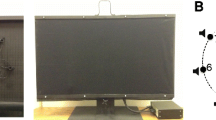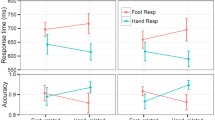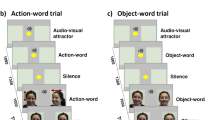The role of verbal labels in the assimilation of information on novel objects depending on the speech learning strategy was studied by assessing the effectiveness of the recognition of novel objects learned using fast mapping and explicit coding strategies, taking oculomotor activity into account. A total of 32 subjects were presented with visual images of eight new plant fruits, each one eight times, with auditory presentation of a unique labels in 50% of cases and a general verbal labels in the other 50%. Visual search of a target image among distractors was used as test task. The findings indicated that the fast mapping provided faster acquisition of new words than explicit encoding. The unique verbal labels of new fruits was found to have a positive influence on performance of the visual search task, this type of designation having greater significance being characteristic of fast mapping in contrast to explicit encoding.
Similar content being viewed by others
References
Atir-Sharon, T., Gilboa, A., Hazan, H., et al., “Decoding the formation of new semantics: MVPA investigation of rapid neocortical plasticity during associative encoding through fast mapping,” Neural Plast., 804385 (2015).
Axelsson, E. L., Swinton, J., Jiang, I. Y., et al., “Prior exposure and toddlers’ sleep-related memory for novel words,” Brain Sci., 11, No. 10, 1366 (2021).
Cesana-Arlotti, N., “Precursors of logical reasoning in preverbal human infants,” Science, 359, No. 6381, 1263–1266 (2018).
Chen, S., Wang, Y., and Yan, W., “More stable memory retention of novel words learned from fast mapping than from explicit encoding,” J. Psycholinguist. Res., (2022).
Chung, H. and Yim, D., “quick incidental learning of words by children with and without specific language impairment: An eye-tracking study,” Commun. Sci. Disord., 25, No. 3, 499–516 (2020).
Cooper, E., Greve, A., and Henson, R. N., “Investigating fast mapping task components: No evidence for the role of semantic referent nor semantic inference in healthy adults,” Front. Psychol., 10, 394 (2019).
Coutanche, M. N. and Thompson-Schill, S. L., “Fast mapping rapidly integrates information into existing memory networks,” J. Exp. Psychol., 143, No. 6, 2296–2303 (2014).
Ellis, E. M., Borovsky, A., et al., “Novel word learning: An eye-tracking study. Are 18-month-old late talkers really different from their typical peers?” J. Commun. Disord., 58, 143–157 (2015).
Feiman, R., Mody Sh., and Carey, S., “The development of reasoning by exclusion in infancy,” Cogn. Psychol., 135, 101473 (2022).
Forder, L. and Lupyan, G., “Hearing words changes color perception: Facilitation of color discrimination by verbal and visual cues,” J. Exp. Psychol. Gen., 148, No. 7, 1105 (2019).
Gnedykh, D. S., Filippova, M. G., Makarova, D. N., and Perikova, E. I., “Challenges and prospects for new word learning research: Rapid mapping versus explicit encoding,” Vestn. St. Peters. Gos. Univ. Psikhologiya, 12, No. 4, 527–543 (2022).
Greve, A., Cooper, E., and Henson, R. N., “No evidence that ‘fast-mapping’ benefits novel learning in healthy older adults,” Neuropsychologia, 60, 52–59 (2014).
Grigoroglou, M., Chan, S., and Ganea, P. A., “Toddlers’ understanding and use of verbal negation in inferential reasoning search tasks,” J. Exp. Child Psychol., 183, 222–241 (2019).
Halberda, J., “Is this a dax which I see before me? Use of the logical argument disjunctive syllogism supports word-learning in children and adults,” Cogn. Psychol., 53, No. 4, 310–344 (2006).
Hill, A., Collier-Baker, E., and Suddendorf, T., “Inferential reasoning by exclusion in children (Homo sapiens),” J. Comp. Psychol., 126, No. 3, 243–254 (2012).
Kotov, A. A. and Kotova, T. N., “Object name pronunciation and the categorizing effect of perception,” Psikhologiya Zh. VShE, 10, No. 3, 75–85 (2013).
Kotov, A. A. and Zherzhdeva, M. R., “The influence of the ease of naming spatial features on learning new categorization rules,” Psikhologiya Zh. VShE, 17, No. 1, 145–155 (2020).
Li, C., Hu, Z., and Yang, J., “Rapid acquisition through fast mapping: stable memory over time and role of prior knowledge,” Learn. Mem., 27, No. 5, 177–189 (2020).
Lyashevskaya, O. N. and Sharov, S. A., Frequency Dictionary of Modern Russian Based on the Russian National Corpus, Azbukovnik, Moscow (2009).
Mason, R. S. and Bass, L. A., “Just ask me again: An analysis of receptive vocabulary performance of children from low-income environments,” Early Educ. Dev., 31, No. 6, 910–926 (2020).
Medina, T. N., Snedeker, J., Trueswell, J. C., and Gleitman, L. R., “How words can and cannot be learned by observation,” Proc. Natl. Acad. Sci. USA, 108, No. 22, 9014–9019 (2011).
Merhav, M., Karni, A., and Gilboa, A., “Not all declarative memories are created equal: Fast mapping as a direct route to cortical declarative representations,” NeuroImage, 117, 80–92 (2015).
Mervis, C. B. and Bertrand, J., “Acquisition of the novel name-nameless category (N3C) principle,” Child Dev., 65, No. 6, 1646 (1994).
Mody, S. and Carey, S., “The emergence of reasoning by the disjunctive syllogism in early childhood,” Cognition, 154, 40–48 (2016).
Morozov, M. I., “How the strength of the link between an object and its category label influences visual search performance,” Russ. J. Cogn. Sci., 4, No. 4, 22–28 (2017).
Perikova, E., Blagovechtchenski, E., Filippova, M., et al., “Anodal tDCS over Broca’s area improves fast mapping and explicit encoding of novel vocabulary,” Neuropsychologia, 168, 108156 (2022).
Pokhodai, M. Yu., Bermudes-Margaretto, B., Shtyrov, Yu. Yu., and Myachikov, A. V., “Eye-tracking methods in psycholinguistics and parallel EEG recording,” Zh. Vyssh. Nerv. Deyat., 72, No. 5, 609–622 (2022).
Repnik, K. R., Not This, but That. Exploring Disambiguation in the Context of Multilingual Word Learning: PhD Thesis (2021), https://era.ed.ac.uk/bitstream/handle/1842/37808/Repnik2021.pdf?sequence=1&isAllowed=y.
Shcherbakova, O. V., Kirsanov, A. S., Filippova, M. G., et al., “Explicit and implicit acquisition of new words: behavioral correlates and neurophysiological mechanisms,” in: From Words to Representations. The Neurocognitive Basis of Verbal Learning, Skifiya-Print, St. Petersburg (2022), pp. 22–96.
Shtyrov, Y., Filippova, M., Blagovechtchenski, E., et al., “Electrophysiological evidence of dissociation between explicit encoding and fast mapping of novel spoken words,” Front. Psychol., 12, 571673 (2021).
Shtyrov, Y., Filippova, M., Perikova, E., et al., “Explicit encoding vs. fast mapping of novel spoken words: Electrophysiological and behavioural evidence of diverging mechanisms,” Neuropsychologia, 172, 108268 (2022).
Souza, A. S., Overkott, C., and Matyja, M., “Categorical distinctiveness constrains the labeling benefit in visual working memory,” J. Mem. Lang., 119, 104242 (2021).
Ting Siok, W., Kay, P., Wang, W. S. Y., et al., “Language regions of brain are operative in color perception,” Proc. Natl. Acad. Sci. USA, 106, No. 20, 8140–8145 (2009).
Trueswell, J. C., Medina, T. N., Hafri, A., and Gleitman, L. R., “Propose but verify: Fast mapping meets cross-situational word learning,” Cogn. Psychol., 66, No. 1, 126–156 (2013).
Vales, C. and Smith, L. B., “Words, shape, visual search and visual working memory in 3-year-old children,” Dev. Sci., 18, No. 1, 65–79 (2015).
Vasilyeva, M. J., Knyazeva, V. M., Aleksandrov, A. A., and Shtyrov, Y., “Neurophysiological correlates of fast mapping of novel words in the adult brain,” Front. Hum. Neurosci., 13, No. 304 (2019).
Warren, D. E. and Duff, M. C., “Not so fast: Hippocampal amnesia slows word learning despite successful fast mapping,” Hippocampus, 24, No. 8, 920–953 (2014).
Warren, D. E., Tranel, D., and Duff, M. C., “Impaired acquisition of new words after left temporal lobectomy despite normal fast-mapping behavior,” Neuropsychologia, 80, 165–175 (2016).
Winawer, J., Witthoft, N., Frank, M. C., et al., “Russian blues reveal effects of language on color discrimination,” Proc. Natl. Acad. Sci. USA, 104, No. 19, 7780–7785 (2007).
Wochna, K. L. and Juhasz, B. J., “Context length and reading novel words: an eye-movement investigation,” Br. J. Psychol., 104, No. 3, 347–363 (2013).
Author information
Authors and Affiliations
Corresponding author
Additional information
Translated from Zhurnal Vysshei Nervnoi Deyatel’nosti imeni I. P. Pavlova, Vol. 73, No. 6, pp. 749–763, November–December, 2023.
Rights and permissions
Springer Nature or its licensor (e.g. a society or other partner) holds exclusive rights to this article under a publishing agreement with the author(s) or other rightsholder(s); author self-archiving of the accepted manuscript version of this article is solely governed by the terms of such publishing agreement and applicable law.
About this article
Cite this article
Perikova, E.I., Filippova, M.G., Makarova, D.N. et al. The Benefits of Labeling in Fast Mapping and Explicit Encoding. Neurosci Behav Physi (2024). https://doi.org/10.1007/s11055-024-01609-7
Received:
Accepted:
Published:
DOI: https://doi.org/10.1007/s11055-024-01609-7




